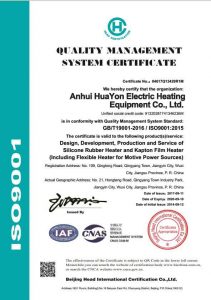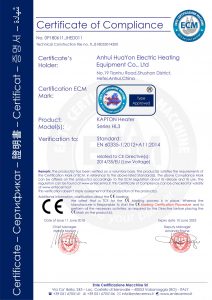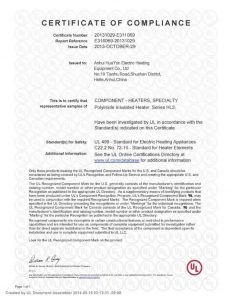Silicone Heating Pad 300X300mm 220V 600W Quick Detail
Applicable Industries: medicine and healthcare, aerospace and aviation, Automotive industry, Consumer electronics
state: New
Type: electric heater
Birthplace:Anhui, China
brand name: HuaYon customize it
Dimension (L*W*H): personalized
Voltage: 3,7 ~ 480 V
1 one year warranty
Working temperature range: -30~200ºC
Material: Silicone rubber + engraved metal sheet
Thickness: 1,5-3 mm
Back adhesive: 3M 467/468 the personalized
Power density: 0,01-2,5 w/cm²
Power deviation: ±5%
Supply capacity: 50000 units per month
Packaging Details: inner PE bag + card
Certificates: THIS, RoHS, ISO9001
Silicone rubber heater is a type of thin film that heats up when electrified, in a standard thickness of 1.5 mm, Adopting nickel-chromium wires or nickel-chromium foils from 0.05 mm ~ 0.10 mm thick engraved in certain shapes, the heating component is wrapped with heat conductors and insulating materials on both sides, and completed in high temperature die forming and aging heat treatment.
Voltage | 3V-480V | Thickness | 1.5mm-3mm |
Power Density | 0.1-1.2W/CM2 | Insulation Ohm | More than 5MΩ |
Min Size | 10*10mm | Max Temperature | 250 degree |
Max Size | 2000*10000mm | Wire Tension | 15N*15N |
What is silicone rubber heater?
Freeze protection and condensation prevention for many types of instrumentation and equipment.
Medical equipment such as blood analyzers and test tube warmers.
Computer peripherals such as laser printers.
Curing of plastic laminates.
Photo Processing Equipment.
Semiconductor Processing Equipment.
Thermal transfer equipment
Drums and other containers and viscosity control and asphalt storage.
Key features and benefits of silicone rubber heaters include:
Flexibility: The flexibility of silicone rubber allows for molding, bend or mold these heaters to fit various shapes and surfaces. This feature makes them suitable for applications where rigid heaters are not practical..
Uniform heating: These heaters distribute heat evenly across their entire surface., mitigating the appearance of hot spots or cold regions and ensuring constant heating.
Quick response to heating: Silicone rubber heaters are known for their fast response times in reaching and adjusting temperatures., making them suitable for applications requiring rapid heating adjustments.
Durability: silicone rubber is resistant to various environmental factors, like humidity, chemicals and moderate physical wear, which improves the robustness of the heater.
Electrical isolation: The electrical insulating properties of silicone rubber ensure safe use in applications where electrical insulation is vital.
Customizable layout: Manufacturers can customize silicone rubber heaters in terms of size, form, power and temperature distribution to meet specific heating requirements.
Silicone rubber heaters are used in a wide spectrum of industries and applications, including:
Industrial processes: Heat tanks, pipelines, valves and manufacturing equipment, and assist in curing operations, drying and preheating.
Medical devices: They are used in medical equipment as IV bag warmers, heated patient warmers and medical imaging tables.
Aerospace and aviation: preventing ice buildup on aircraft components by deicing critical areas such as wings.
Food and beverage industry: maintenance of specific temperatures in food processing equipment, such as boilers and tanks, during production processes.
electronics: Integration in electronic cabinets, display panels and other devices for temperature regulation.
Automotive section: Used in seat heating applications, defrosting windows and preheating engines in vehicles.
The silicone heating pad, that measures 300×300 mm and has a nominal power of 220 V y 600 W, is a flexible heating element commonly used in various applications requiring uniform and efficient heat distribution. Here are the key details about this specific heating pad:
Material: Made with silicone rubber, providing durability, flexibility and resistance to humidity and chemicals. Esto lo hace adecuado para una amplia gama de entornos.
Dimensiones: La almohadilla mide 300 mm por 300 mm (about 11,8 inches by 11,8 inches), lo que proporciona un área considerable para la distribución del calor.
Voltaje y Potencia: Funciona a 220 voltios y tiene una potencia de 600 watts. Este nivel de potencia es suficiente para generar una cantidad significativa de calor, lo que lo hace eficaz para diversas aplicaciones de calefacción.
Aplicaciones:
3d print: A menudo se utiliza como cama caliente en impresoras 3D para garantizar la adhesión adecuada del objeto impreso y evitar deformaciones.
Industrial: Adecuado para mantener la temperatura en maquinaria, tuberías o tanques.
Comercial: Se utiliza en equipos de servicio de alimentos para mantener los alimentos calientes o en entornos de laboratorio para mantener temperaturas específicas para experimentos.
Characteristics:
Uniform heating: la construcción de silicona permite una distribución uniforme del calor en toda la superficie.
Adhesive backing: Algunas versiones vienen con un respaldo adhesivo para una fácil fijación a las superficies.
Temperature control: se puede combinar con termostatos o controladores de temperatura para regular la producción de calor con precisión.
Seguridad y eficiencia: Las almohadillas calefactoras de silicona están diseñadas para ser seguras y energéticamente eficientes, y muchos modelos incorporan fusibles térmicos o sensores de temperatura para evitar el sobrecalentamiento.
![]()
![]()





Reviews
There are no reviews yet.